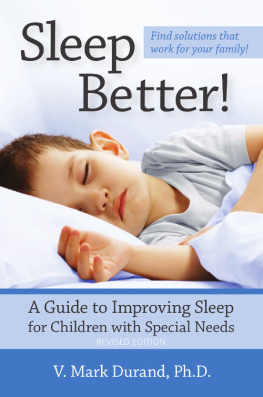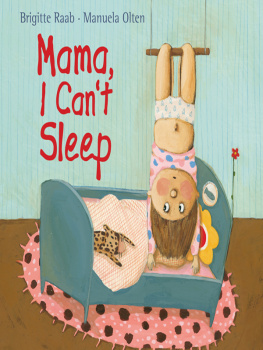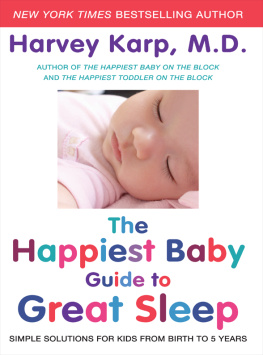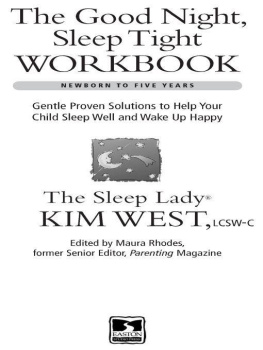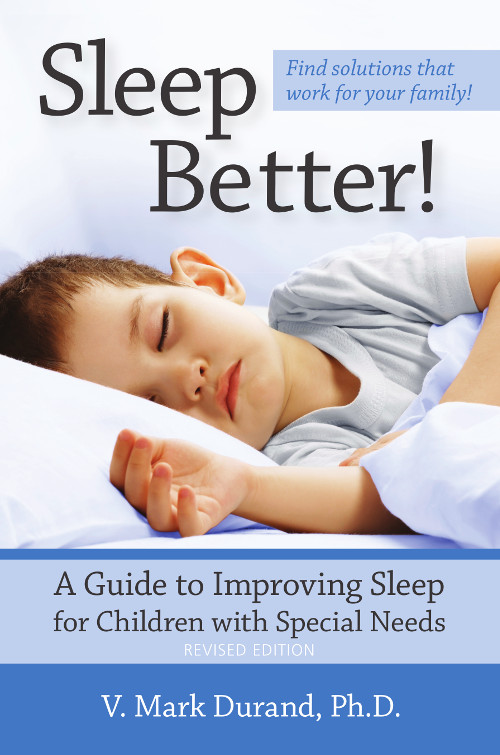
Sleep Better!
A Guide to Improving Sleep for Children with Special Needs
Revised Edition
by
V. Mark Durand, Ph.D.
University of South Florida St. Petersburg

Baltimore London Sydney

Paul H. Brookes Publishing Co.
Post Office Box 10624
Baltimore, Maryland 21285-0624
USA
www.brookespublishing.com
Copyright 2014 by Paul H. Brookes Publishing Co., Inc.
All rights reserved.
Previous edition copyright 1998.
Paul H. Brookes Publishing Co. is a registered trademark of
Paul H. Brookes Publishing Co., Inc.
Cover photo iStockphoto.com/idal. Clip art 2013 Jupiterimages Corporation.
Case examples are based on the authors experiences. Identifying details are used with permission in certain cases; otherwise, names and identifying details have been masked to protect confidentiality.
Purchasers of Sleep Better! A Guide to Improving Sleep for Children with Special Needs, Revised Edition, are granted permission to download, print, and/or photocopy the blank forms in for clinical purposes. None of the forms may be reproduced to generate revenue for any program or individual. Unauthorized use beyond this privilege is prosecutable under federal law. You will see the copyright protection notice at the bottom of each photocopiable form.
Library of Congress Cataloging-in-Publication Data
Durand, Vincent Mark.
Sleep better! a guide to improving sleep for children with special needs / by V. Mark Durand, Ph.D.Revised edition.
pages cm
Includes .
ISBN 978-1-59857-294-0 (pbk. : alk. paper)ISBN 1-59857-294-6 (pbk. : alk. paper)ISBN 978-1-59857-466-1 (epub)ISBN 1-59857-466-3 (epub)
1. Sleep disorders in childrenPopular works. 2. ChildrenSleepPopular works. I. Title.
RJ506.S55D87 2013
618.92'8498dc23 2013031407
British Library Cataloguing in Publication data are available from the British Library.
Version 1.0
Contents
Breathing-Related Sleep Problems
This Will Never Get Better or May Become Worse
Disruptive Night Waking
Problems with Depression
Prevention Strategies
About the Reproducible Forms
Purchasers of this book may download blank forms in .
About the Author
V. Mark Durand, Ph.D., is known worldwide as an authority in the area of autism spectrum disorder. He is Professor of Psychology at the University of South Florida St. Petersburg (USFSP), where he was the founding Dean of Arts and Sciences and Vice Chancellor for Academic Affairs. Dr. Durand is a fellow of the American Psychological Association and has received more than $4 million in federal funding to study behavior problems in children with disabilities.
Dr. Durand was awarded the University Award for Excellence in Teaching at the State University of New YorkAlbany in 1991 and in 2007 was given the Chancellors Award for Excellence in Research and Creative Scholarship at USFSP. Dr. Durand is currently a member of the Professional Advisory Board for the Autism Society of America. He is the coeditor of the Journal of Positive Behavior Interventions and has written 12 books, including abnormal psychology textbooks that are used at more than 1,000 universities worldwide (translated into Arabic, Greek, Spanish, Portuguese, French, Hindi, and Chinese). In addition, he has more than 100 research publications.
Major themes in Dr. Durands research include the assessment and treatment of severe behavior problems for children and adults with autism, parent training, and the development of treatments for child sleep problems. He developed one of the most popular functional behavioral assessment instruments used todaythe Motivation Assessment Scale (MAS; Monaco & Associates, 1992)that is now translated into 15 languages.
Dr. Durand developed a unique treatment for severe behavior problemscalled functional communication trainingthat is used worldwide. More recently, he developed an innovative approach to help families work with their challenging children and published a guide for parents and caregivers parents and caregivers of children with challenging behavior (Optimistic Parenting: Hope and Help for You and Your Challenging Child; Paul H. Brookes Publishing Co., 2011). The book has won several national awards.
Preface to the Revised Edition
It has been approximately 15 years since the initial publication of Sleep Better! A Guide to Improving Sleep for Children with Special Needs. During the decade and a half since its release, a significant number of studies advanced our understanding about the nature of sleep problems in children with a range of disorders (e.g., attention-deficit/hyperactivity disorder, Asperger syndrome, autism spectrum disorder, Williams syndrome). In addition, an increasing number of studies now document a growing evidence base for the interventions initially described in the Sleep Better! book. Unfortunately, what has not advanced significantly in the intervention literature is the theme of contextual fit that ran throughout the book. Studies that look at the effectiveness of particular techniques (e.g., bedtime fading, sleep restriction) continue to examine the effectiveness of each approach or compare approaches as if all families are willing and able to use these interventions successfully and interchangeably. Little attention is paid to individual differences in families and their circumstances that can serve as obstacles to the effectiveness of certain treatments.
A major theme of the first edition of Sleep Better! was making clear that many families struggle with some of the more frequently recommended intervention approaches. For example, families often told us that using one of the more popular treatments of the daygraduated extinction, which required parents to listen to the cries of their childwas too upsetting to them. Their feelings of guilt (Why am I doing this to my child, who already has so many other challenges?) made them stop this approach prematurely. On the other hand, some parents prefer this type of intervention over ones that involve their staying up late at night or waking early in the morning (e.g., sleep restriction). The book highlighted the pros and cons of each approach and offered families choices based on their own needs and preferences. In fact, the feedback from families indicated that this was one of the books greatest strengths. They liked that no one particular approach was being sold to them but rather, that they could pick and choose and sometimes modify techniques to fit their own schedules and needs.
We have taken this approach one step further and looked directly at these obstacles. In our work with families who are dealing with sleep problems as well as many other behavioral challenges presented by their child, we find that emotional reactions and self-talk (e.g., I must be a bad parent if I cant control my childs behavior, Other people are judging me because my child misbehaves, My childs disorder is the reason behind this disruption and therefore cant really be changed) get in the way of following behavioral plans. In other words, when families do not follow through on suggested programs, this can sometimes be attributed to these attitudinal barriers rather than their being unmotivated or not receiving enough training. In a large randomized clinical trial, we documented that helping families with these interfering thoughts and feelings could help them assist their child more effectively and led to reports of improved quality of life (called
Next page
